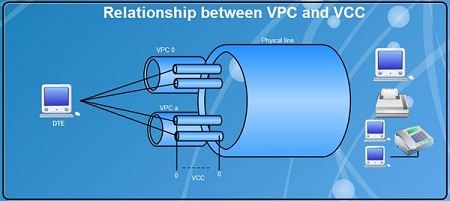Cell switching is associated with Asynchronous Transmission Mode (ATM) which is considered to be a high speed switching technology that attempted to overcome the speed problems faced by the shared media like Ethernet and FDDI. Cell switching uses a connection-oriented packet-switched network.
When a connection is established it is known as signaling. It is called cell switching because this methodology uses a fixed length of packets of 53 bytes out of which 5 bytes are reserved for header. Unlike cell technology, packet switching technology uses variable length packets. Even though cell switching closely resembles packet switching because cell switching also breaks the information into smaller packets of fixed length and thereby ensuring guaranteed delays.
Cell switching has many advantages. High performance, common LAN/WAN architecture multimedia support, dynamic bandwidth, and scalability. High performance is achieved because this technology uses hardware switches. Cell switching uses virtual circuit rather than physical circuit, therefore it is not necessary to reserve network resources for a particular connection. Also, once a virtual circuit is established switching time is minimized, which ensures higher network throughputs.
The cell has a fixed length of 53 bytes out of which 48 bytes are reserved for payloads and 5 bytes act as header. The header contains payload-type information, virtual-circuit identifiers, and header error check.
Cell switching has features of circuit switching, as .it is a connection-oriented service where each connection during its set up phase creates a virtual circuit. The connection, oriented virtual circuits for each phase allocates specified resources for different streams of traffic. This makes cell switching a cost effective service.
We’ll be covering the following topics in this tutorial:
Virtual Connections in Cell Switching
The virtual connection in cell switching may be achieved using two types of connections. These are virtual channel connections (VCC) and virtual path connections (VPC). A VPC consists of all VCCs. VPC switches between different cells for bundling virtual circuits together between switches. Figure explains the relationship between VPC and VCc. These virtual circuits can be statically configured as permanent virtual circuits (PVC) or Switched Virtual Circuits (SVC).

Virtual Path
Virtual Channel Identifier (VCI), Virtual Path Identifier (VPI) are used to identify a cell on a physical transmission medium. VPI and VCI are same for cells belonging to the same virtual connection on a shared transmission medium. Cell switching uses a 24-bit identifier for virtual circuits out of which 8-bit are used for Virtual Path Identifier (VPI) and 16-bit for Virtual Circuit Identifier (VCI). VPI is a field in the cell header, which is used to establish virtual path between two networks having ATM switches. In other words, these switches in the network Will make forwarding decision based on VPI field. From the host point of view, it may be considered as a virtual circuit network with 8-bit circuit identifiers. Data flow from different networks using network to network interface (NNI) to the public switches using user network interface (UNI) utilizes all 24 bits including the 16 bit for VCI, NNI and UNI are explained during the discussion of ATM technology. This has been explained in Figure where each VPC; has bundle of VCC. All of these VCCs have same 8 bits. This avoids a huge table having the information of each VCI.
 Dinesh Thakur holds an B.C.A, MCDBA, MCSD certifications. Dinesh authors the hugely popular
Dinesh Thakur holds an B.C.A, MCDBA, MCSD certifications. Dinesh authors the hugely popular